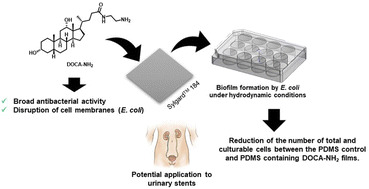Insights into the antimicrobial properties of a cationic steroid and antibiofilm performance in PDMS-based coatings to potentially treat urinary infections†
Abstract
Currently, multidrug-resistant (MDR) infections are one of the most important threats, driving the search for new antimicrobial compounds. Cationic peptide antibiotics (CPAs) and ceragenins (CSAs) contain in their structures cationic groups and adopt a facially amphiphilic conformation, conferring the ability to permeate the membranes of bacteria and fungi. Keeping these features in mind, an amine steroid, DOCA-NH2, was found to be active against reference strains and MDR isolates of Gram-positive Enterococcus faecalis and Staphylococcus aureus and Gram-negative Escherichia coli and Pseudomonas aeruginosa. The compound was active against all the tested microorganisms, having bactericidal and fungicidal activity, displaying minimal inhibitory concentrations (MICs) between 16 and 128 μg mL−1. No synergy with clinically relevant antibacterial drugs was found. However, the compound was able to completely inhibit the biofilm formation of bacteria exposed to the MIC of the compound. For E. coli and E. faecalis, inhibition of biofilm formation occurred at half the MIC. Besides, DOCA-NH2 inhibited the dimorphic transition of Candida albicans at concentrations 4 times lower than the MIC, and can reduce the microorganism virulence and biofilm formation was significantly reduced at both MIC and half the MIC. Polydimethylsiloxane-based coatings containing DOCA-NH2 (0.5, 1.0, and 1.5 wt%) were prepared and tested against the E. coli biofilm formation under hydrodynamic conditions similar to those prevailing in ureteral stents. A biofilm reduction of approximately 80% was achieved when compared to the control.

- This article is part of the themed collection: #MyFirstJMCB


 Please wait while we load your content...
Please wait while we load your content...